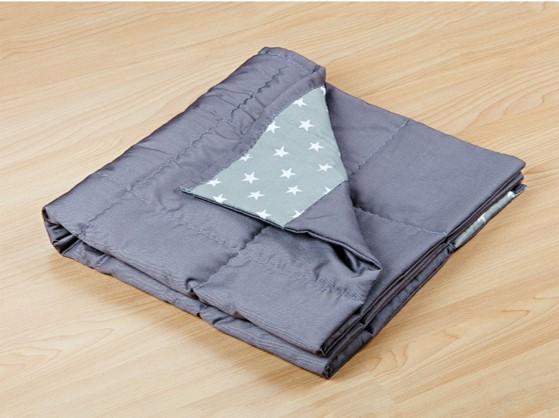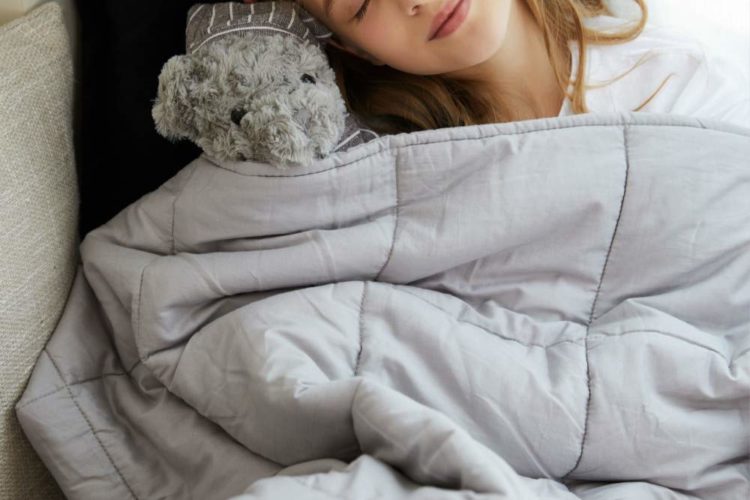What is a Weighted Blanket?
This is a sensible question and the answer is simple. It is exactly that, a blanket with small weights all over the blanket. The idea is to apply a firm consistent pressure to the person underneath. Think of a prolonged hug while sleeping.
Weighted Blankets and the Sensory Connection…
For some Children (and adults) that have trouble sleeping, they have challenges in calming down, lowering the arousal level in the brain and relaxing sufficiently to drift off to sleep.
This difficulty with switching between our arousal levels is often linked to sensory processing difficulties.
Lying under a weighted blanket give extra proprioceptive and tactile input. This input can be calming and promote relaxation. (A weighted blanket can be used to relax at any time, not just for sleep.)
The constant pressure from a weighted blanket can be very relaxing, decrease anxiety, and help the body transition into sleep, this has an almost magical effect on some children. It helps relax the nervous system by simulating the feeling of being held or hugged.
Sleep is really important for children in general, but a lack of sleep can actually exacerbate the symptoms of children with sensory processing disorders. These children often have trouble calming themselves at the end of an active day. Once they are asleep they are often restless and frequently wake up in the night. Children with Autism and Sensory Processing Disorder (SPD) have definite sensory needs, which is why weighted blankets are often recommended and have excellent results.
Are Weighted Blankets the answer?
Sensory needs are unique to every individual. While it may be tremendously helpful for a child with sensory needs, Autism, or SPD to use a weighted blanket to improve falling asleep or staying asleep, it also may not at all. It is really worthwhile considering the signs that your child may benefit from a weighted blanket, or may not like it at all.
[If they don’t like it, they won’t use it. Never force your child to use one]
Here are some guidelines that indicate your child may responds well to a weighted blanket:
- Loves sleeping or lying under piles of blankets
- Enjoys crawling into tight spaces or behind furniture
- Has difficulty relaxing and sitting still (even after a lot of physical activity)
- Likes wearing heavy sweatshirts and sweaters
Signs Your Child May Not Respond to a Weighted Blanket:
- Is tactile defensive (very sensitive to touching different textures)
- Does not like sleeping or lying under blankets
If your child is old enough, show them pictures of one and explain what it is and how it feels. Ask if they think it would help them. Children are often very tuned into their needs and will give honest answers.
Remember to discuss the use of a weighted blanket with your child’s Occupational Therapist.
How heavy should the weighted blanket be?
Weighted blankets should be used under the direction of a professional. Too much weight is detrimental for a young child
As a guideline, 10% of the child’s body weight plus approximately 500grams is the usual consideration. Please ensure you get professional guidance on the use of a weighted blanket.
How to Use a Weighted Blanket
This may seem a bit obvious, but here are some more ideas for how to use your weighted blanket!
- First and foremost, NEVER force a child to use a weighted blanket. You can demonstrate on yourself and encourage, but remember we’re talking about sensory input and a weighted blanket may actually feel painful to your child.
- When first presenting the weighted blanket to your child, pull it up slowly from their feet and lay it down on top of them. Ask them what they think!
- If your child could benefit from some calm down time outside of bedtime, try wrapping the weighted blanket around them while they sit on the couch or floor while reading, playing board games, doing homework, etc.
- Used in a sensory area that you use as a place to calm down. Your child can go and use it whenever they need it.
- Weighted blankets can also be used in a classroom setting, as part of a sensory diet. Some classrooms have sensory tents or corners of their own.
- Give your child breaks when using their weighted blanket. At night, once they’ve fallen asleep, see if they will stay asleep once this is off. A nice guide (especially during the day) is to wear it for 20 mins at a time with a 2 hour break. This ensures that the body does not become too used to the sensation and feel overwhelmed once it’s taken off.
Beyond Weighted Blankets…?
sensoryTIME have a range of weighted blankets and lap pads available. Please check out our website www.sensoryTIME.ae .
Please contact us if you have any queries about the appropriate use of the weighted products, our Sensory Integration professionals are on hand to advise on their use.

(adapted from an article in Your Kid’s Table)
